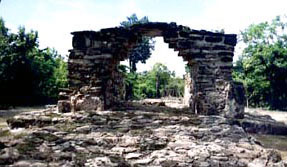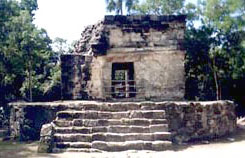| The name Cozumel (Isla Cozumel) means "Land of the Swallow" in Mayan, and was named so due to the indigenous, graceful birds that can be seen regularly patrolling Cozumel's beautiful beaches and coastline. Cozumel was settled roughly 2000 years ago by ancient Mayans, a seafaring people, who saw Cozumel as a commercial trading stop as well as a sacred shrine. | ||
|
The island of Cozumel was a mecca to Mayan women who made the voyage from the mainland to Isla Cozumel in large dugout canoes to worship Ix Chel, the Goddess of fertility. Leaving the mainland from what is now Playa del Carmen and Tulum, Mayan women crossed the treacherous channel in open canoes to give offerings at the alter site of Ix Chel. What remains now of the altar and ceremonial center of Ix Chel can be seen at the San Gervasio ruins site near the center of the island. Historically speaking, the group's migration was doubly important. First, because the Mestizos and Mayans would be responsible for permanently settling the Mexican Caribbean coast; and secondly, because repopulating that area ultimately produced a consolidated group with economical and political power that continues to this day. The genesis of the Yucatan's east coast development, which later became the state of Quintana Roo, was a direct result of the War of the Castes. It was a conflict that changed the economic, demographic, and political geography of the peninsula and initiated the process of subdivisions and territories as the population was pushed out of the region. So it is also that the Mestizos and white Yucatecans that lived in the South of Quintana Roo, in Bacalar and the surrounding area, went to repopulate what today is known as Belize, specifically Orange Walk, Corozal and Ambergris. Most of these settlers returned to Mexico at the end of the 19th century and populated Payo Obispo (Chetumal), Bacalar and Xcalak. The north was repopulated with emigrants from Valladolid, Espita, Tizimin and other villages. From that point on, the islands of Holbox, Mujeres and Cozumel would always maintain a population.  During this same period of time newly authorized officials divided up sections of Cozumel Island and distributed lots among the island's new settlers. These first citizens were Spanish descendants, some of whose surnames were: Novelo, Angulo, Alcocer, Cardenas, Rivero, Vivas, Aguilar, Anduze, Ezquivel, Vega, Martin and Coral. One of the elements that unified the group was their Catholic faith, which was the dominant religion among Yucatecos. One of the immigrants, a Catholic priest, had brought an image of Saint Michael with him, and San Miguel quickly became the patron saint of the island. The power of the church also worked well in controlling the Mayan farmers who had settled in El Cedral because they too were profoundly Catholic. During this same period of time newly authorized officials divided up sections of Cozumel Island and distributed lots among the island's new settlers. These first citizens were Spanish descendants, some of whose surnames were: Novelo, Angulo, Alcocer, Cardenas, Rivero, Vivas, Aguilar, Anduze, Ezquivel, Vega, Martin and Coral. One of the elements that unified the group was their Catholic faith, which was the dominant religion among Yucatecos. One of the immigrants, a Catholic priest, had brought an image of Saint Michael with him, and San Miguel quickly became the patron saint of the island. The power of the church also worked well in controlling the Mayan farmers who had settled in El Cedral because they too were profoundly Catholic.Once political and religious power had been established and the land distributed, the citizens set about establishing occupational specialization between ranchers, artisans and merchants. It would be the merchants who would consolidate the island's interior market, which initially grew out of the necessity for bartering between the citizens of San Miguel and the residents of El Cedral; and between the Cozumeleno merchants and seasonal fisherman from Cuba and Belize. The Cuban fisherman exchanged manufactured products from Havana for fresh food and drinking water. In actuality, two different immigrant groups made it to the shores of Cozumel that first year. The first group was made up of 51 middle class families who made their way from the city of Valladolid, accompanied by 86 mestizo male servants. The second group consisted of 350 poor Mayans who came from the outskirts of Valladolid, but felt ideologically connected to the more urban group and elected to join them. Thus the first people to repopulate Cozumel arrived as a group with a history that instantly divided them according to work assignment and class distinction.  The mestizos that formed the dominant group of the newly born society had a European-Mayan culture, were bilingual and dressed like white Yucatecans. Their experience in the market economy would be determined by events that had taken place as the island was first repopulated. The mestizos that formed the dominant group of the newly born society had a European-Mayan culture, were bilingual and dressed like white Yucatecans. Their experience in the market economy would be determined by events that had taken place as the island was first repopulated.The best land was appropriated in parcels of 10 to 200 hectares and the village of San Miguel was divided into lots for building homes. The field workers, who had arrived in the second wave of immigrants, were relocated in the El Cedral area and given excellent agricultural land. They, in turn, organized their own disbursement system that tended to parcel out land based on the individual's ability to work. The first action by the dominant group was to communicate with Merida and advise them of the new settlement, and so it was that on November 21, 1849, only two years after the War of Castes was initiated, Quintana Roo Governor Barbachano established the village of San Miguel on Cozumel Island. By 1970, Cozumel's population had grown to 10,000 inhabitants and by the year 2000 had reached 65,000. Now, over a decade later, the island boasts a population of more than 100,000 residents. The only explorers that visit Cozumel these days are those looking to discover the beauty of the sun, sand, and sea. |
 It was Spanish Conquistador Juan de Grijalva who first discovered Cozumel in 1518 as he was blown off course during a journey to Cuba. Grijalva left a golden statue as a gift when he departed which now resides in the downtown San Miguel Cathedral.
It was Spanish Conquistador Juan de Grijalva who first discovered Cozumel in 1518 as he was blown off course during a journey to Cuba. Grijalva left a golden statue as a gift when he departed which now resides in the downtown San Miguel Cathedral.